The dry start is a special way to set up a plant aquarium or aquascape. The aquarium is set up as usual, meaning that after the introduction of the substrate (usually nutritious soil) the decoration is added, followed by planting the tank.
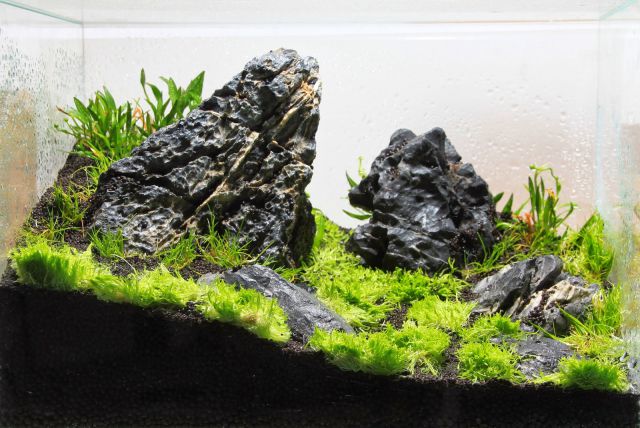
Usually now the tank would be flooded and the tech getting installed. When performing a dry start however, things are different from this point on and a moderately moist - but not wet environment is created for the aquatic plants which will be kept growing in their emersed form for an amount of time. Only after the plants have developed well and spread on the substrate, the aquarium is filled with water. The benefits of this dry-start method are described below.
After the completion of the planting, all of the aquarium equipment is now sufficiently moistened with a spray bottle. The tank is closed almost completely with a cover, so that the degree of humidity within the aquarium is maintained. The simplest solution here is a cover made of cling film..
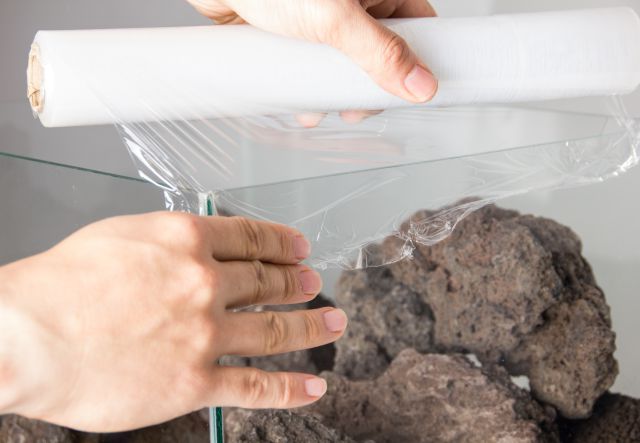
Where tech is concerned, only the lighting is put into operation. From day one, longer lighting times with up to 10hrs can be realized. It is even possible to keep the tank tech-free if sufficient light is available in the tank’s location.
What happens with the plants?
Most aquatic plants, available in trade as potted or in-vitro product are still in their emersed form (surface form). During the dry start, the plants can continue to grow in their initial form and don’t need to switch to their submersed (underwater) form. However, pure underwater plants such as Vallisneria-, Blyxa- or Najas-sorts are not suitable for this method because they can not develop a landform. In terms of content and technology, a "dry start" is therefore also related to the topic of Wabi-Kusa, in which aquatic plants are kept in open glass dishes.
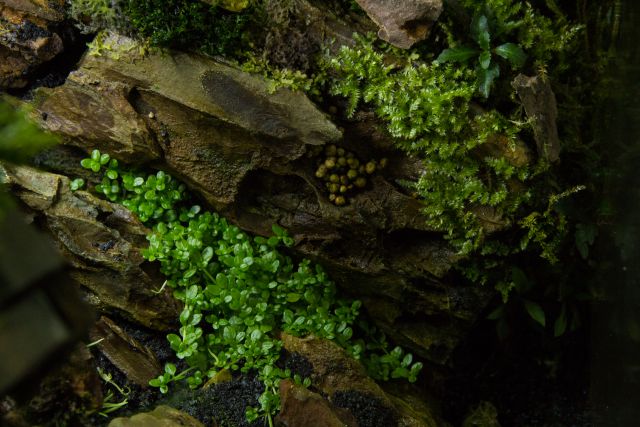
Mosses and ground cover like Hemianthus callitrichoides "Cuba" can develop emersed during a dry start.
Care
A dry start aquarium requires very little care during the early growth phase. Only lighting is needed, which is usually switched on and off automatically via a timer. Other technical components are not necessary at this time. Fertilizing the aquatic plants during this phase is not necessary, either. If nutritious substrate is used (soil), the plants can very well subsist on the nutrients in the substrate via their roots. A CO2 system is not needed, either during a dry start, but only after having flooded the aquarium and running it “wet”. The plants get the necessary carbon from the surrounding air. Just make sure that the moisture level in the aquarium is maintained and the plants do not dry up. To achieve this, you should moisten the contents of the aquarium every now and then with a spray bottle. Especially plants in higher areas - close to the lamp - tend to dry up quicker and need to be looked after more conscientiously. A minimal gas exchange is also recommended to prevent mold. For this purpose, the aquarium can be briefly ventilated as needed.
Humidity
As already discussed in the section "Care", the right level of humidity is important in order to create a good growth environment for aquarium plants. The emphasis here is on moderately damp and not wet (hence the name "dry start"), because too much humidity does not lead to success. Especially with waterlogging in the soil substrate, it often happens that the plants rot. Likewise, too high a water level in combination with appropriate lighting can lead to algae growth in the upper regions of the soil.
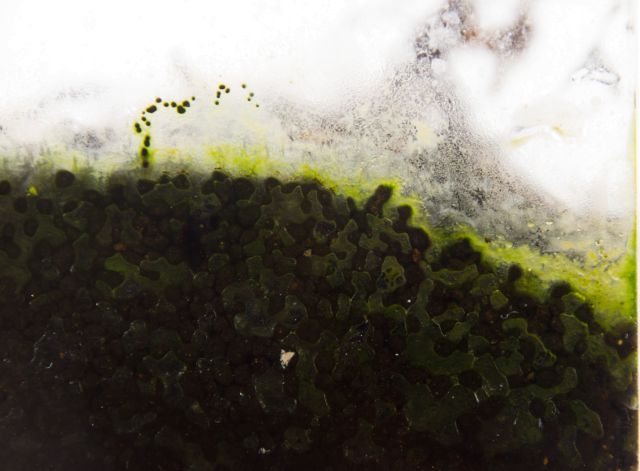
Algae growth in the soil due to high water level.
A visible or increasing water level is therefore not a good thing and should be eliminated. For this purpose, you can dig a small pit into the substrate somewhere in the foreground, which reaches almost to the bottom plate. At this point you can now use a thin tube (preferably with 4/6 mm diameter) to suck off excess water. This little pit also serves as a visual control: if too much water accumulates in the ground, a visible puddle will form.
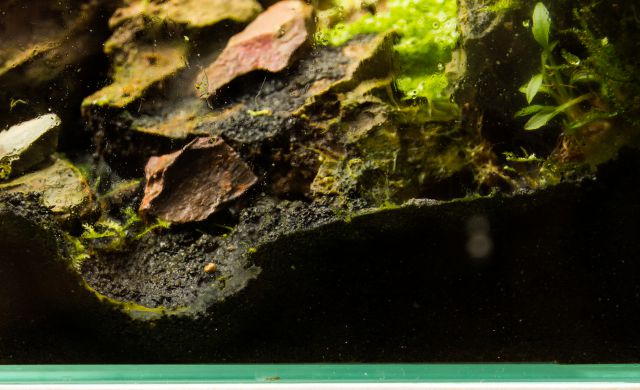
The pit in the left corner serves the purpose of controlling the water level.
In addition, you need not only to eliminate excessive wetness during the dry start but also the cause of it by significantly reducing the water input (by spraying). In a closed system hardly any water is consumed by evaporation, unless the cover has been designed too open. A good sign of a functioning system are permanently slightly-fogged panes and the formation of condensation droplets on the cover.
When does it make sense to do a dry start?
It is disputed, whether aquarium plants grow faster than in a traditionally driven aquarium. But this isn’t supposed to be the benefit of performing a dry start. A dry start is recommended in aquascaping layouts with lots of mosses, ground cover and also epiphytes. In aquariums with a focus on stem plants we’d advise against a dry start. However, mosses and ground cover benefit very much from a dry start, as they can excellently strike root or grow onto the hardscape.
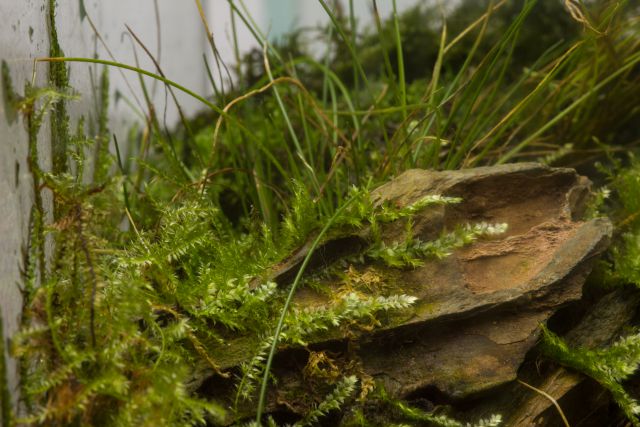
Mosses are perfect for a dry start and grow splendidly onto the hardscape.
Carpeting plants are often caused to bop up by burrowing animals or strong oxygen production during an old-fashioned aquarium start and’ll have to be laboriously re-planted, especially when they weren’t very well planted in the first place. Plants supposed to stick to hard substrates like mosses or other epiphytes need to be fixed using tools (like glue or string). When performing a dry start, those plants can just grow onto and into the hardscape (stones and driftwood) or substrate in peace after just having been laid onto it. To make sure everything’s growing well, an aquarium is usually operated for two to four weeks in the dry-start process, before it is flooded and then run "wet".
A dry start is also advantageous for the microbiological balance, because in the humid environment, sessile bacteria that are already useful, can settle in the soil. Frequently, flooded dry start aquariums do not have a particularly large ammonium and nitrite peak and thus can already be occupied by animals after a shorter period of time.